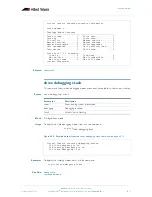
Stacking Introduction
©2008 Allied Telesis Inc. All rights reserved.
Software Version 5.2.1
AlliedWare Plus
TM
Operating System Software Reference C613-50003-00 REV E
64.11
VCS Failure Recovery
If the stack master either fails or is removed, the other stack members will decide which of two
actions to take.
1.
Fallback action.
2.
Re-elect a new stack master.
Note that a master fail-over will be slower than a slave failure and will require the restart
(reconvergence) of routing protocols such as RIP.
The
“State-change-table” on page 64.10
shows how the slave members would respond to
various problems occurring on the master stack member.
Fallback Action
To initiate this action the remaining stack members will disconnect all ports, then activate using
the fallback config file.
In order to provide an efficient alternative configuration, you should create a fallback config file
that reflects the most appropriate working configuration for the failures that you feel are most
likely to occur. One way to do this is to create a fall back file from your working system, then
edit this file to provide an appropriate backup system configuration. See
stack fallback-config
command on page 65.18
.
Re-elect New Stack Master
The slave members automatically determine which slave member becomes the new VCS
master.
Recombining Broken Stacks
When two broken stacks (stubs) are reconnected, a multiple master condition will be detected.
In this situation, a single Master is elected based upon the lowest Priority ID or the lowest MAC
address. The 'losing' master and the new joining stack members will reboot and join the single
stack as ordinary stack members.
Stack Maintenance
Adding a Stack Member
An unstacked switch can be added to an existing stack (hot swapped in) with minimal impact
on traffic. To do this, power down the new member switch, then connect its stacking ports and
power on the switch. The switch will boot as a member of the stack.
Removing a Stack Member
A stack member can be removed from a stack (hot swap out) with minimal impact on stack
traffic. To do this power-down the stack member, disconnect its XEM-STK ports. Insert the
new stack member, reconnect the stacking ports and power-up the new stack member.
You can seamlessly swap a slave switch into the stack to replace another with the same
configuration. This provides a simple way to remove an out of service switch with minimal
impact, and minimal administration requirement. You should configure the replacement switch
with the same member ID as its replacement prior to its insertion into the stack.
















































